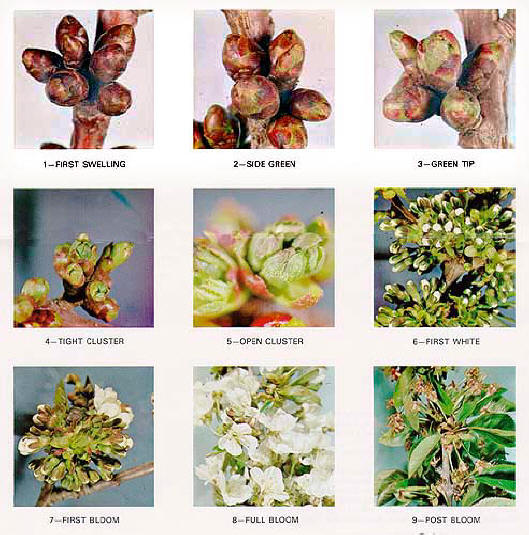
Growing premium fresh sweet cherries since 1918
Viable blossom
Frozen blossom
Notice the difference between the bases of the blossoms. The frozen blossom's ovary is brown and would not produce a cherry.
FROST PROTECTION
Spring
temperatures are the most crucial in growing fruit. From early March
through the first few days of May, nighttime temperatures frequently drop below
freezing. Depending on the stage of development, from first bud to small
fruit, these chilly temperatures can ruin an entire crop.
From
mid-March through April, we spend many wee hours of the morning driving
through the orchards. Along with trying to stay awake, we are constantly
monitoring temperatures, lighting smudgepots, starting wind
machines, and running sprinklers. Smudgepots burn fuel to warm the air
near the trees. Wind machines are used to keep the air circulating,
which can raise the temperature a few degrees. When the irrigation water
is available later in the spring, we use sprinklers to spray water on the
ground and bottom of the trees. The ice actually insulates the buds and
the moisture raises the dew point.
The critical temperature at which damage to the cherry crop will occur changes as the crop matures. The chart below was developed by the WSU Research Extension in Prosser, Washington, and details the critical temperatures.

|
Development Stage |
1 | 2 | 3 | 4 | 5 | 6 | 7 | 8 | 9 |
|
Average Date for Stage |
3/5 | 3/13 | 3/23 | 3/27 | 4/1 | 4/4 | 4/8 | 4/13 | 4/21 |
|
Avg Temp for 10% klil (°F) |
17 | 22 | 25 | 26 | 27 | 27 | 28 | 28 | 28 |
|
Avg Temp for 90% klil (°F) |
5 | 9 | 14 | 17 | 21 | 24 | 25 | 25 | 25 |
Although it is a lot of
effort and expense to implement these preventive measure, those two or three
degrees that we might raise the temperature could mean the difference between
a fantastic crop and a disastrous crop - especially later in the spring.
Location also plays a key factor in protecting the cherry crop from frost.
After decades of driving around monitoring temperatures,
we
learned which areas tend to be warmer than others. We have located our
cherry orchards in the best spots available in our region.
In the springtime when you see your trees and flowers starting to bud and bloom, just cross your fingers for us to give us a little extra luck - we might need it! We will thank you with some beautiful, delicious cherries in June and July. Don't forget to preorder your cherries today!
© 2003-2008 Olmstead Orchards, Inc. 360 Frazer Road Grandview, Washington 98930
Last updated Tuesday June 03, 2008 Website problems: webmaster@olmsteadorchards.com
Site by CH Design
